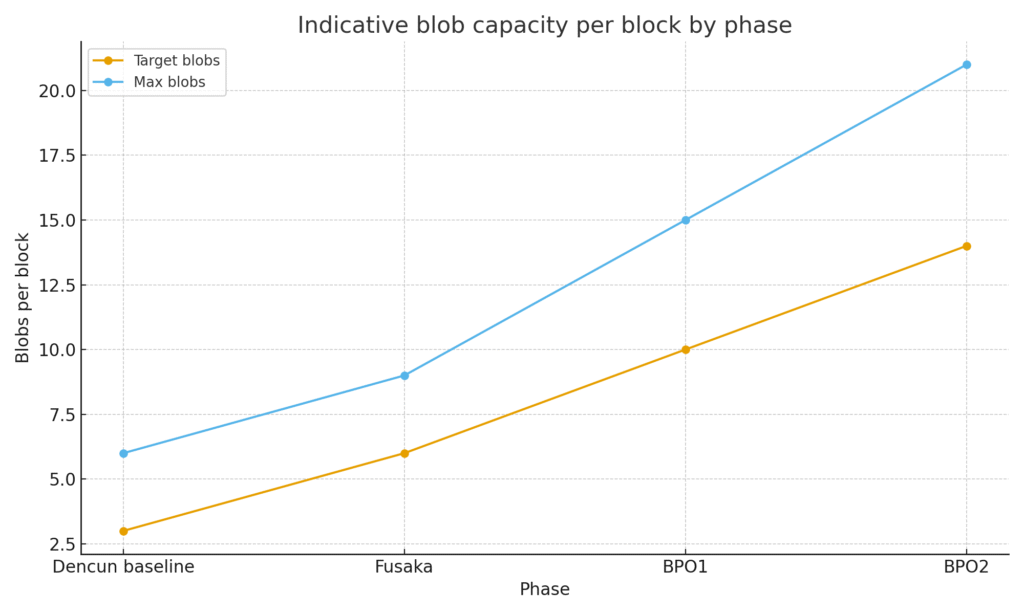
Ethereum Fusaka Sepolia is the next parameter update on the Ethereum test network that many rollups depend on for data posting. The activation on Sepolia is a low risk rehearsal for mainnet that helps client teams and operators validate blob settings batch behavior and monitoring. This guide explains what the upgrade changes why OP Stack chains must prepare which versions to run and how Erigon 3.2.0 fits into a clean rollout.
What is the Ethereum Fusaka Sepolia upgrade
Ethereum Fusaka Sepolia upgrade is a hard fork that introduces Blob Parameter Only changes. The fork adjusts blob target and blob maximum to scale data throughput without a full feature bundle. It continues the path set after Dencun where data availability moved to blob space. Fusaka is designed to be simple to adopt and safe to iterate with follow up BPO waves.
How the Ethereum Fusaka Sepolia upgrade works step by step
The network activates the new blob parameters at a known slot on a test network such as Sepolia.
Clients that are Fusaka ready enforce the new target and maximum blob counts per block and update the fee adaptation rules for blob space.
Rollups that post data to layer one use the new parameters when constructing batches. They also verify that data availability remains within limits under peak load.
Client and infra teams monitor bandwidth and inclusion rates to decide next BPO steps.
Why the Ethereum Fusaka Sepolia upgrade matters for OP Stack chains on Sepolia
OP Stack chains that publish their data to Sepolia must complete a readiness release before activation. The goal is to ensure that nodes, batchers and provers continue to function when the layer one rules change. The required versions are public and the update is straightforward for most operators. It is not a change to the rollup protocol itself. It is a compatibility upgrade with the upstream chain.
Operator checklist for today
| Component | Required action | Minimum version or commit | Notes |
|---|---|---|---|
| OP Stack node | Upgrade to the latest Fusaka readiness release | op node v1.14.1 or newer | Supersedes the previous tag that had a bug. Restart after upgrade |
| OP Stack batcher | Upgrade to the matching batcher release | op batcher v1.16.0 or newer | Follow the release notes for flags and roll out plan |
| Execution client | Verify compatibility on your chosen client | Erigon 3.2.0 or equivalent client release | Erigon ships complete Fusaka implementation and schedules on test networks |
| Consensus client | Confirm that your client is built with current configs | Latest Sepolia ready build | Check for sample flags like max blobs where available |
| Monitoring | Watch blob inclusion and batch delays | Update dashboards and alerts | Track gas per blob, batch latency and bandwidth |
Erigon 3.2.0 for Ethereum Fusaka Sepolia at a glance
Erigon 3.2.0 includes a complete Fusaka implementation and schedules it on key test networks. That matters for operators who prefer Erigon for fast sync and archive performance. The release aligns with the Sepolia timeline and is a safe default for those testing the fork today. If you run mixed client stacks in production you should stage the same release pattern across test nodes to reduce surprises.
Benefits and risks of Ethereum Fusaka Sepolia
Benefits
Higher blob headroom with minimal rule changes
Faster iteration cycles based on measured network data
Clear runbooks for operators and client teams
Risks
Bandwidth pressure during busy posting windows
Misaligned versions across mixed client stacks
Custom tooling that assumes legacy blob parameters
What to watch next for Ethereum Fusaka Sepolia
Mainnet activation is expected in early December subject to final test results
Follow up BPO waves can raise blob capacity further once bandwidth and inclusion are stable
Client teams may ship safety flags such as max blobs to cap what a proposer builds under your hardware and network limits
Rollups should measure batch latency and posting failures through the activation windows and adjust their alert budgets accordingly
Timeline for operators
Testnets activate first and serve as the staging ground for client and tooling checks
Sepolia activation follows and remains the reference chain for rollups that post data there
Mainnet proceeds only after stable test outcomes and green client matrices

Figure 1. Ethereum Fusaka Sepolia indicative blob capacity per phase from Dencun baseline to Fusaka and early BPO waves
Conclusion
Fusaka on Sepolia is a low drama but high impact rehearsal. It lifts data room through simple parameter moves and keeps the door open for safe scaling through BPO waves. For OP Stack operators the path is clear. Upgrade node and batcher, verify client parity and watch blob metrics during activation. For execution client users Erigon 3.2.0 is a strong choice for testing today. Read this alongside your internal change controls and hold the mainnet window on your runbooks.
Related Posts
Tokenised stocks need real investor safeguards models gaps and the path forward
Ethereum Fusaka BPO explained how blob only forks safely boost layer two throughput October 2025
External Sources
Optimism notice Fusaka readiness for chains that post to layer one Sepolia and mainnet
OP Stack release notes op node v1.14.1 Fusaka readiness and op batcher v1.16.0
Erigon release v3.2.0 with complete Fusaka implementation and testnet schedules
Ethereum Foundation testnet announcement and activation table for Holesky Sepolia and Hoodi
EthPandaOps bandwidth and proposer settings note for Fusaka including max blobs guidance

